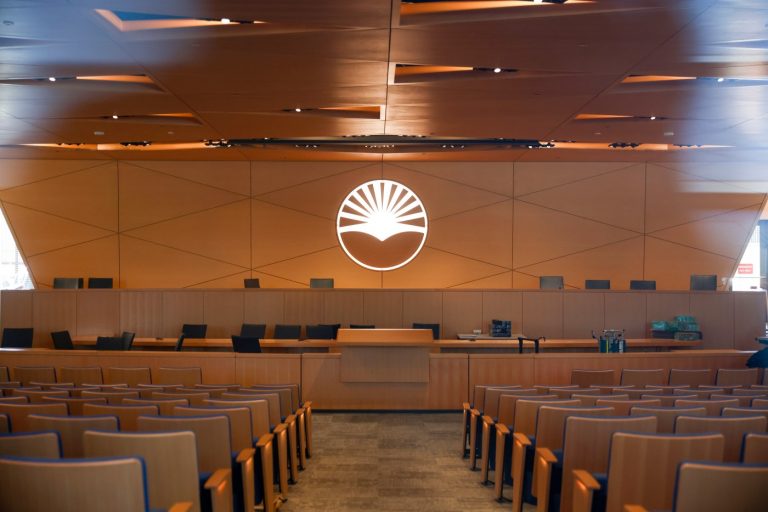OROVILLE — The Butte County Board of Supervisors unanimously adopted the Butte County Recharge Action Plan during its meeting Tuesday in an effort to help bolster groundwater reserves throughout the region.
Department of Water and Resource Conservation Director Kamie Loeser brought the item before the board with a presentation by Assistant Director Christina Buck, who helped head the project. Loeser said the plan was spurred by Gov. Gavin Newsom’s executive order last year that loosened restrictions on collecting floodwater. After the order, Butte County put forth a letter of intent to create a project.
“The plan identifies five main actions with accompanying implementation steps that the county will pursue in partnership with the groundwater sustainability agencies and other agencies and organizations within the county,” Loeser said.
With the approval of the board, the plan will also be sent to the California Department of Water Resources.
Buck said the plan was also derived from the considerable amount of stormy weather last year that led to flooding throughout the county, adding that the plan also culminates from data and studies conducted.
“This is just a good opportunity to kind of reorganize where we are today locally with the studies that we’ve done in recent years, through our office and through others, to understand our recharge process and what the opportunities are,” Buck said. “We wanted to keep it brief and concise to focus the conversation and give us a launching point to know what those next steps could be.”
Additionally, Buck said the plan would focus on wet periods during dry years to slow down the drainage to let it soak into the ground to capture it.
Emphasis was put on the Vina Subbasin because of the impact the drought has had on its water storage.
“This is a Butte County Recharge Action Plan, but very quickly we begin focusing in on the Vina Subbasin, and there is an opportunity for continued creative groundwater management and water resource management in the other two subbasins, Butte and Wyandotte Creek,” Buck said. “But it’s Vina that really has a problem as evidenced both by our estimates of groundwater demand and reduced groundwater storage.”
As of the presentation on Tuesday, the Vina Subbasin has a water deficit of roughly 550,000 acre-feet for its storage. Buck said the subbasin also faces a yearly decline of about 20,000 acre-feet on top of an increase in demand for the area serviced.
Related Articles
Butte County Supervisors to consider groundwater recharge plan
Meet the candidates: Julie Threet
Meet the candidates: Doug Teeter
Butte County approves funding for former sheriff substation demolition
Proposition 1 changes funding appropriations, behavioral health director says
Five actions were recommended in the plan going forward. The first is to slow down flood flows and spread the water out to directly aid recharge efforts. Buck said this could be done through networking with those managing floods, groundwater and the drought. It was noted in the presentation that water could be spread onto agricultural land and lower foothill areas.
The second action is to then retain water from rainfall and runoff in farmland.
Action three is to manage water flow throughout the various channels such as the Lindo Channel, followed by action four which is to “maximize the use of existing and underutilized surface water supplies,” as laid out in the presentation.
Finally, the fifth action focuses on government policy and water rights to determine water ownership and related concerns.
“If you have surface water and the right to recharge that water, it does remain surface water and owned by the entity that put it there,” Buck said. “The exception to that has been clarified really through the executive order and now in the water code is related to those flood flows. So if we’re operating under this flood flow piece, the lead water code is very specific that the entity that’s putting those flood flows are creating opportunities for that flood flow to make it into the groundwater.”
Buck said that those working on the project will need to be aware of the legality of claiming water even when collecting it for groundwater recharge purposes.
The plan was presented before the Butte County Water Commission before it went to the Board of Supervisors and the commission recommended the adoption of the plan. Commissioner Ernie Washington sat in on the board meeting presentation and provided some comments on the plan.
“During my tenure, which has been in excess of 10 years, I think this document is probably one of the most positive things that we’ve done,” Washington said. “And I was really glad to serve on the ad hoc committee. I want to thank the members of the department and particularly Christina (Buck) for putting together a really good document, and I hope you’ll see the benefit in it. We can do something sooner rather than later.”
The board unanimously approved the plan which went into effect immediately.
Other business
Aside from approving the recharge plan, the board looked at the following actions:
• An opioid awareness presentation was given with county maps showing where drugs such as fentanyl are the most prevalent.
• The board unanimously voted to pen a letter in opposition to AT&T’s request to halt landline services. Concerns were brought up regarding emergency events and the need to reach people during power outages.
• In a unanimous vote, the board opted to raise the cost of a full autopsy from $1,700 to $2,000 for services provided by Dr. Katherine Raven, a forensic pathologist.













+ There are no comments
Add yours